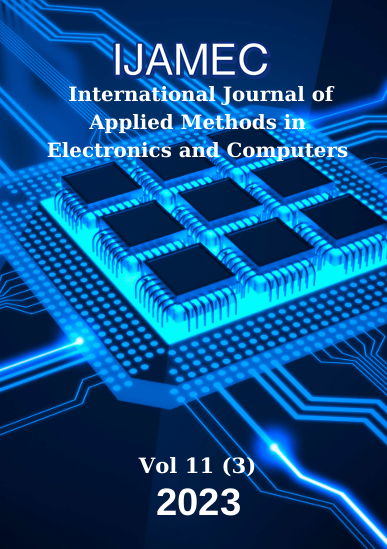Benchmarking of ResNet models for breast cancer diagnosis using mammographic images
DOI:
https://doi.org/10.58190/ijamec.2023.39Keywords:
Breast cancer, Cancer diagnosis, CNN, ResNet modelsAbstract
Breast cancer is one of the cancer types with a high mortality rate worldwide. Early diagnosis is of great importance to reduce this mortality rate. Computer-aided early diagnosis systems enable doctors to make more precise and faster decisions. The Mammographic Image Analysis Society (MIAS) dataset was used in this study. The breast area was selected by masking in mammography images. The number of images was increased using data augmentation techniques. Mammography images were classified as normal, benign and malignant using four different ResNet models. The highest classification accuracy was achieved by using ResNet18 model with 93.83%. The accuracies obtained with ResNet50, ResNet101 and ResNet152 were 87.24%, 87.44% and 91.25% respectively.
Downloads
References
Chauvet, C., Giving Tuesday, in International Agency for Research on Cancer. 2020.
Weiderpass, E., Global cancer estimates from IARC, in International Agency for Research on Cancer. 2021.
Goodfellow, I., Y. Bengio, and A. Courville, Deep learning. 1 ed. Vol. 1. 2016: Massachussets Institute of Technology. 801.
Hussain, M., J.J. Bird, and D.R. Faria, A Study on CNN Transfer Learning for Image Classification, in 18th Annual UK workshop on computational intelligence. 2018.
Taşdemir, S., et al., Ysa kullanılarak mamogramlardan dokusal öznitelik tabanlı meme kanseri ilgi bölgesi sınıflandırılması. Mühendislik Bilimleri ve Tasarım Dergisi, 2020.
Alruwaili, M. and W. Gouda, Automated Breast Cancer Detection Models Based on Transfer Learning. Sensors (Basel), 2022. 22(3).
Krishna, T.H. and C. Rajabhushanam, Mammography image breast cancer detection using deep transfer learning. Advances and Applications in Mathematical Sciences, 2021(20:7): p. 1187-1196.
Görgel, P., A. Sertbas, and O.N. Uçan, Computer-aided classification of breast masses in mammogram images based on spherical wavelet transform and support vector machines. The Journal of Knowledge Engineering, 2015. 32(1): p. 155-164.
Zhang, Y.-D., et al., Computer-aided diagnosis of abnormal breasts in mammogram images by weighted-type fractional Fourier transform. Advances in Mechanical Engineering, 2016. 8(2).
Zhang, Y., et al., Smart detection on abnormal breasts in digital mammography based on contrast-limited adaptive histogram equalization and chaotic adaptive real-coded biogeography-based optimization. SIMULATION, 2016. 92(9): p. 873-885.
Vedalankar, A.V., S.S. Gupta, and R.R. Manthalkar, Addressing architectural distortion in mammogram using AlexNet and support vector machine. Informatics in Medicine Unlocked, 2021. 23: p. 100551.
Sha, Z., L. Hu, and B.D. Rouyendegh, Deep learning and optimization algorithms for automatic breast cancer detection. International Journal of Imaging Systems and Technology, 2020. 30(2): p. 495-506.
Civcik, L., Görüntü zenginleştirme ve hücresel ysa kullanarak meme kanseri teşhisi, in Electical - Electronic. 2013, Selcuk University: Konya p. 154.
Mader, K.S., Mias mammography. 2017.
Suckling, J., et al. The Mammographic Image Analysis Society digital mammogram database. 1994.
Wada, K. Image polygonal annotation with python. 2018; Available from: https://github.com/wkentaro/labelme.
Mitrano, P. and D. Berenson, Data augmentation for manipulation, in Robotics: Science and Systems. 2022: New York City, NY, USA.
Igerata, A., How to split a tensorflow dataset into train, validation, and test sets. Towards Data Science, 2021.
Joseph, V.R. and A. Vakayil, SPlit: An Optimal Method for Data Splitting. Technometrics, 2022. 64(2): p. 166-176.
Boesch, G., Deep residual networks (ResNet, ResNet50), in Deep Learning. 2022.
Tsang, S.-H. Resnet-winner of ilsvrc 2015 image classification, localization, detection. 2018 [cited 2022 29th Sep.]; Available from: https://towardsdatascience.com/review-resnet-winner-of-ilsvrc-2015-image-classification-localization-detection-e39402bfa5d8.
Sachan, A. Detailed guide to understand and implement resnet. Learn Machine Learning, AI & Computer vision 2019 [cited 2022 29th Sep.]; Available from: https://cv-tricks.com/keras/understand-implement-resnets.
LE, K., A quick overview of resnet models. 2021, MLearning.ai.
He, K., et al., Deep Residual Learning for Image Recognition. 2015.
Gerry, P. Why are keras models instantiated with imagenet weights only? 2020; Available from: https://stackoverflow.com/questions/62739893/why-are-keras-models-instantiated-with-imagenet-weights-only.
Pattanayak, S., Pro deep learning with tensorflow. 2017: Apress. 412.
Çarkacı, N., Derin öğrenme uygulamalarında başarım iyileştirme yöntemleri. Medium, 2017.
Das, A., et al., Classification of succulent plant using convolutional neural network, in 2nd International Conference on Cyber Security and Computer 2020, Daffodil International University.
Koklu, M., et al., A CNN-SVM study based on selected deep features for grapevine leaves classification. Measurement, 2022. 188: p. 110425.
Hoo, Z.H., J. Candlish, and D. Teare, What is an ROC curve? Emergency Medicine Journal, 2017. 34(6): p. 357-359.
Downloads
Published
Issue
Section
License
Copyright (c) 2023 International Journal of Applied Methods in Electronics and Computers

This work is licensed under a Creative Commons Attribution-ShareAlike 4.0 International License.





